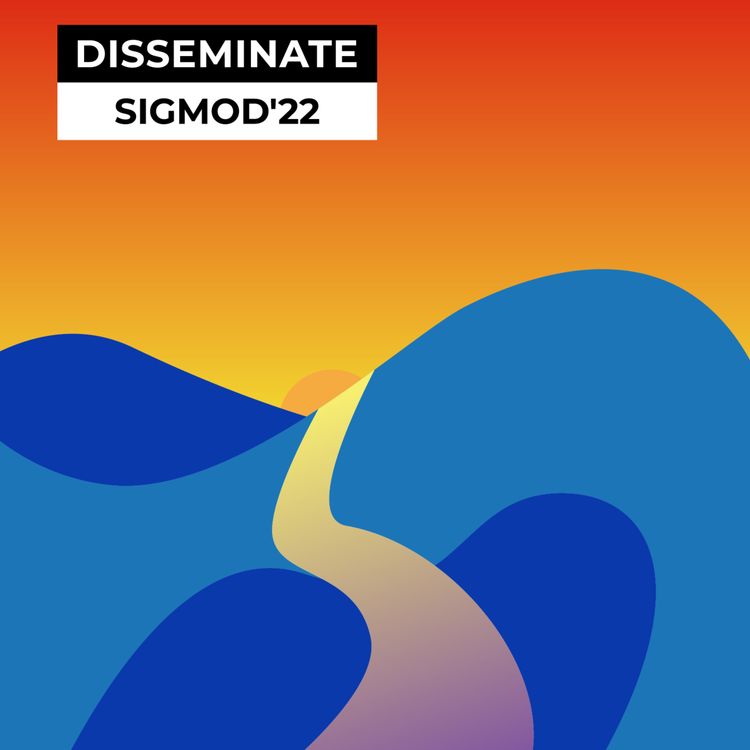Share

Disseminate
Hani Al-Sayeh | Juggler: Autonomous Cost Optimization and Performance Prediction of Big Data Applications | #6
Distributed in-memory processing frameworks accelerate iterative workloads by caching suitable datasets in memory rather than recomputing them in each iteration. Selecting appropriate datasets to cache as well as allocating a suitable cluster configuration for caching these datasets play a crucial role in achieving optimal performance. In practice, both are tedious, time-consuming tasks and are often neglected by end users, who are typically not aware of workload semantics, sizes of intermediate data, and cluster specification. To address these problems, Hani and his colleagues developed Juggler, an end-to-end framework, which autonomously selects appropriate datasets for caching and recommends a correspondingly suitable cluster configuration to end users, with the aim of achieving optimal execution time and cost.
1:02 - Can you introduce your work and describe the current workflow for developing big data applications in the cloud?
2:49 - What is the challenge (maybe hidden challenge) facing application developers in this workflow? What harms performance?
5:36 - How does Juggler solve this problem?
11:55 - As an end user, how do I interact with Juggler?
14:07 - Can you talk us through your evaluation of Juggler? What were the key insights?
16:30 - What other tools are similar to Juggler? How do they compare?
18:17 - What are the limitations of Juggler?
21:57 - Who will find Juggler the most useful? Who is it for?
24:05 - Is Juggler publicly available?
24:23 - What is the most interesting (maybe unexpected) lesson you learned while working on this topic?
27:50 - What is next for Juggler? What do you have planned for future research?
28:49 - What attracted you to this research area?
29:45 - What do you think is the biggest challenge now in this area?
- Juggler: Autonomous Cost Optimization and Performance Prediction of Big Data Applications (SIGMOD 2022 paper)
- Juggler SIGMOD 22 presentation
- CherryPick: Adaptively Unearthing the Best Cloud Configurations for Big Data Analytics (NSDI 2017 paper)
- Ernest: Efficient Performance Prediction for Large-Scale Advanced Analytics (NSDI 2016 paper)
- Email: hani-bassam.al-sayeh@tu-ilmenau.de
- TU Ilmenau Database and Information Systems Group
More episodes
View all episodes

21. Anastasiia Kozar | Fault Tolerance Placement in the Internet of Things | #61
49:02||Season 6, Ep. 21In this episode, we chat with Anastasiia Kozar about her research on fault tolerance in resource-constrained environments. As IoT applications leverage sensors, edge devices, and cloud infrastructure, ensuring system reliability at the edge poses unique challenges. Unlike the cloud, edge devices operate without persistent backups or high availability standards, leading to increased vulnerability to failures. Anastasiia explains how traditional methods fall short, as they fail to align resource allocation with fault tolerance needs, often resulting in system underperformance.To address this, Anastasiia introduces a novel resource-aware approach that combines operator placement and fault tolerance into a unified process. By optimizing where and how data is backed up, her solution significantly improves system reliability, especially for low-end edge devices with limited resources. The result? Up to a tenfold increase in throughput compared to existing methods. Tune to learn more! Links:Fault Tolerance Placement in the Internet of Things [SIGMOD'24]The NebulaStream Platform: Data and Application Management for the Internet of Things [CIDR'20]nebula.stream
20. Liana Patel | ACORN: Performant and Predicate-Agnostic Hybrid Search | #60
52:49||Season 6, Ep. 20In this episode, we chat with with Liana Patel to discuss ACORN, a groundbreaking method for hybrid search in applications using mixed-modality data. As more systems require simultaneous access to embedded images, text, video, and structured data, traditional search methods struggle to maintain efficiency and flexibility. Liana explains how ACORN, leveraging Hierarchical Navigable Small Worlds (HNSW), enables efficient, predicate-agnostic searches by introducing innovative predicate subgraph traversal. This allows ACORN to outperform existing methods significantly, supporting complex query semantics and achieving 2–1,000 times higher throughput on diverse datasets. Tune in to learn more!Links:ACORN: Performant and Predicate-Agnostic Search Over Vector Embeddings and Structured Data [SIGMOD'24]Liana's LinkedInLiana's X
9. High Impact in Databases with... David Maier
01:02:24||Season 7, Ep. 9In this High Impact episode we talk to David Maier.David is the Maseeh Professor Emeritus of Emerging Technologies at Portland State University. Tune in to hear David's story and learn about some of his most impactful work.The podcast is proudly sponsored by Pometry the developers behind Raphtory, the open source temporal graph analytics engine for Python and Rust.You can find David on:HomepageGoogle Scholar
19. Raunak Shah | R2D2: Reducing Redundancy and Duplication in Data Lakes | #59
31:09||Season 6, Ep. 19In this episode, Raunak Shah joins us to discuss the critical issue of data redundancy in enterprise data lakes, which can lead to soaring storage and maintenance costs. Raunak highlights how large-scale data environments, ranging from terabytes to petabytes, often contain duplicate and redundant datasets that are difficult to manage. He introduces the concept of "dataset containment" and explains its significance in identifying and reducing redundancy at the table level in these massive data lakes—an area where there has been little prior work.Raunak then dives into the details of R2D2, a novel three-step hierarchical pipeline designed to efficiently tackle dataset containment. By utilizing schema containment graphs, statistical min-max pruning, and content-level pruning, R2D2 progressively reduces the search space to pinpoint redundant data. Raunak also discusses how the system, implemented on platforms like Azure Databricks and AWS, offers significant improvements over existing methods, processing TB-scale data lakes in just a few hours with high accuracy. He concludes with a discussion on how R2D2 optimally balances storage savings and performance by identifying datasets that can be deleted and reconstructed on demand, providing valuable insights for enterprises aiming to streamline their data management strategies.Materials:SIGMOD'24 Paper - R2D2: Reducing Redundancy and Duplication in Data LakesICDE'24 - Towards Optimizing Storage Costs in the Cloud
8. High Impact in Databases with... Aditya Parameswaran
58:57||Season 7, Ep. 8In this High Impact episode we talk to Aditya Parameswaran about his some of his most impactful work.Aditya is an Associate Professor at the University of California, Berkeley. Tune in to hear Aditya's story! The podcast is proudly sponsored by Pometry the developers behind Raphtory, the open source temporal graph analytics engine for Python and Rust.Links:EPIC Data LabAnswering Queries using Humans, Algorithms and Databases (CIDR'11)Potter’s Wheel: An Interactive Data Cleaning System (VLDB'01)Online Aggregation (SIGMOD'97)Polaris: A System for Query, Analysis and Visualization of Multi-dimensional Relational Databases (INFOVIS'00)Coping with Rejection PonderYou can find Aditya on:TwitterLinkedInGoogle Scholar
18. Marco Costa | Taming Adversarial Queries with Optimal Range Filters | #58
37:07||Season 6, Ep. 18In this episode, we sit down with Marco Costa to discuss the fascinating world of range filters, focusing on how they help optimize queries in databases by determining whether a range intersects with a given set of keys. Marco explains how traditional range filters, like Bloom filters, often result in high false positives and slow query times, especially when dealing with adversarial inputs where queries are correlated with the keys. He walks us through the limitations of existing heuristic-based solutions and the common challenges they face in maintaining accuracy and speed under such conditions.The highlight of our conversation is Grafite, a novel range filter introduced by Marco and his team. Unlike previous approaches, Grafite comes with clear theoretical guarantees and offers robust performance across various datasets, query sizes, and workloads. Marco dives into the technicalities, explaining how Grafite delivers faster query times and maintains predictable false positive rates, making it the most reliable range filter in scenarios where queries are correlated with keys. Additionally, he introduces a simple heuristic filter that excels in uncorrelated queries, pushing the boundaries of current solutions in the field.SIGMOD' 24 Paper - Grafite: Taming Adversarial Queries with Optimal Range Filters
7. High Impact in Databases with... Ali Dasdan
01:03:02||Season 7, Ep. 7In this High Impact episode we talk to Ali Dasdan, CTO at Zoominfo. Tune in to hear Ali's story and learn about some of his most impactful work such as his work on "Map-Reduce-Merge".The podcast is proudly sponsored by Pometry the developers behind Raphtory, the open source temporal graph analytics engine for Python and Rust.Materials mentioned on this episode:Map-Reduce-Merge: Simplified Relational Data Processing on Large Clusters (SIGMOD'07)The Art of Doing Science and Engineering: Learning to Learn, Richard HammingHow to Solve It, George PolyaSystems Architecting: Creating & Building Complex Systems, Eberhardt RechtinYou can find Ali on:TwitterLinkedIn
17. Matt Perron | Analytical Workload Cost and Performance Stability With Elastic Pools | #57
52:10||Season 6, Ep. 17In this episode, we dive deep into the complexities of managing analytical query workloads with our guest, Matt Perron. Matt explains how the rapid and unpredictable fluctuations in resource demands present a significant challenge for provisioning. Traditional methods often lead to either over-provisioning, resulting in excessive costs, or under-provisioning, which causes poor query latency during demand spikes. However, there's a promising solution on the horizon. Matt shares insights from recent research that showcases the viability of using cloud functions to dynamically match compute supply with workload demand without the need for prior resource provisioning. While effective for low query volumes, this approach becomes cost-prohibitive as query volumes increase, highlighting the need for a more balanced strategy.Matt introduces us to a novel strategy that combines the best of both worlds: the rapid scalability of cloud functions and the cost-effectiveness of virtual machines. This innovative approach leverages the fast but expensive cloud functions alongside slow-starting yet inexpensive virtual machines to provide elasticity without sacrificing cost efficiency. He elaborates on how their implementation, called Cackle, achieves consistent performance and cost savings across a wide range of workloads and conditions. Tune in to learn how Cackle avoids the pitfalls of traditional approaches, delivering stable query performance and minimizing costs even as demand fluctuates wildly.Links:Cackle: Analytical Workload Cost and Performance Stability With Elastic Pools [SIGMOD'24]Matt's Homepage
6. High Impact in Databases with... Andreas Kipf
53:06||Season 7, Ep. 6In this High Impact episode we talk to Andreas Kipf about his work on "Learned Cardinalities". Andreas is the Professor of Data Systems at Technische Universität Nürnberg (UTN). Tune in to hear Andreas's story and learn about some of his most impactful work.The podcast is proudly sponsored by Pometry the developers behind Raphtory, the open source temporal graph analytics engine for Python and Rust.Papers mentioned on this episode:Learned Cardinalities: Estimating Correlated Joins with Deep Learning CIDR'19The Case for Learned Index Structures SIGMOD'18Adaptive Optimization of Very Large Join Queries SIGMOD'18You can find Andreas on:TwitterLinkedIn Google ScholarData Systems Lab @ UTN